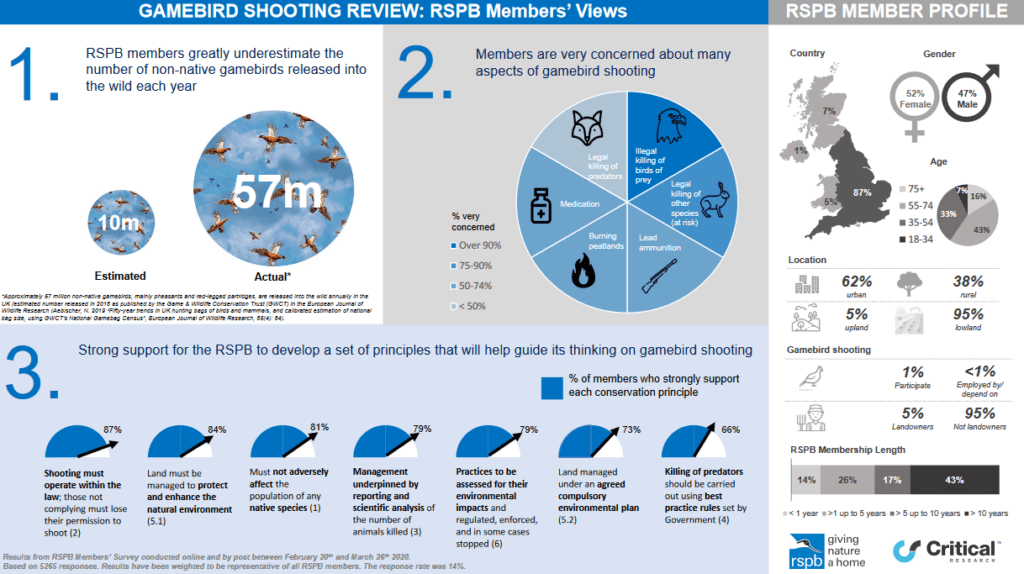
The RSPB is taking its time over this consultation on gamebird shooting but it is going to be worth it.
The infographic that the RSPB has released is clearly not the whole picture, and is an interesting selection of information. There is quite a lot of food for thought here alone.
RSPB members are 62% urban cf 38% rural – does that make them sound very urban to you? What is the average UK person, do you think? Answer: 83% urban cf 17% rural. In other words, as I’ve always pointed out here, the RSPB membership is very rural compared with the population as a whole – they (we) aren’t a bunch of townies. In fact it would be interesting to see what a similar split for the Countryside Alliance might be – more or less rural than the RSPB? I’d say that the RSPB membership urban:rural split is pretty good for a nature conservation organisation which wants to reach out to all but where the focus of the actions it desires are going to be rural in nature.
We RSPB members are quite old though aren’t we? However, it’s a bit difficult to compare these figures with the population as a whole because the RSPB isn’t counting under 18yos and most available official data split the age groups at 65 rather than 55, but we’re older than average it looks to me. But the gender split is pretty much as expected.
I was interested to see that RSPB members were pretty unsighted when it comes to how many non-native gamebirds are released each year. That has to be the RSPB’s fault to some extent – informing one’s membership of the facts not only is part of the RSPB charitable objects but is also quite a good idea if you want them to care about the same things that you do as an organisation. It would be interesting to know how many RSPB members who were well-informed got their information from the RSPB and how many from other sources.
The pie chart on what the RSPB membership cares about in regard to shooting is fascinating. Unsurprisingly the illegal killing of birds of prey is unpopular with RSPB members – unsurprising for three reasons: first, that would be the view of most reasonable people; second, it’s what you’d expect members of the RSPB to feel; third, it’s the bit of the subject that the RSPB does bang on about a lot and in which it is seen to be active.
But the fact that more than half of RSPB feel very strongly about legal killing of other species which are at risk (which might include Mountain Hares and Grey Partridge), as well as burning peatlands, lead ammunition and medicated grit is fairly phenomenal.
And we can only speculate how many RSPB members, but it is between 0% and 50%, care very strongly about the scale of legal killing of predators (I assume this is Red Foxes, Stoats etc). Depending on where that number lies it might be a bit of an eye-opener for the RSPB including for its own practices on its nature reserves.
Let’s just pause and think where some of these issues about which more than half of RSPB members care very strongly come together. Burning peatlands, illegal killing of birds of prey, medicated grit, lead ammunition? Why, that will be driven grouse shooting won’t it?
When we look at the support for the principles that the RSPB laid out then the support for them is overwhelming – figures of 2 out of 3 for everything, 3 out of 4 for most things and 4 out of 5 for many things. That is more uniformity of view, in a membership of over 1 million folk, than most political parties would have in their memberships of many, many fewer on almost any issue.

If one looks at the individual principles then the most supported is, unsurprisingly, that shooting should operate within the law – and although many shoots across the UK probably do, it is perfectly clear where the major class offenders lie – in driven grouse shooting. The map of the disappeared Hen Harriers could not be used in a court of law but it strongly indicates widespread illegal persecution of this one species on driven grouse moors. And the long term data on Peregrine nesting success and, and, and… Just saying.
The least strongly supported, but still at a very high 66% of the membership is that idea that ‘killing of predators should be carried out using best practice rules set by Government’. I can imagine people failing to support this principle for a variety of reasons and so the 1/3 minority may include people who; don’t believe in predator control at all, don’t trust codes of conduct, don’t trust the government and /or don’t care about the moral aspects of killing things.
Even this peek at the results is fascinating. It gives the RSPB a kick up the backside to be bolder. A kick up the backside from its membership in very clear terms.
Let us hope that the RSPB AGM in October (with social distancing?) is given a harder line on gamebird shooting from RSPB Council. With these figures to inform their views then there is no reason to hang back timidly any longer. Indeed, with such strong concern on these issues the RSPB will undoubtedly lose support if, after asking, it doesn’t take a harder line on shooting gamebirds.
What would I like the RSPB to do? As a member, I’d like RSPB to:
- support a ban on driven grouse shooting
- call for an immediate ban on the sale and use of lead ammunition in hunting in the UK
- argue strongly for reform of Pheasant and Red-legged Partridge shooting with reductions in the scale of gamebird releases
- stop treating shooting organisations as though they are mates and treat them as a part of the problem
- develop a position on animal welfare issues, with experts, to inform the RSPB’s practice and policy positions
What I don’t want the RSPB to do:
- bottle out
- say they need to think hard about it
[registration_form]
I suspect that Central, and West End of, London would somehow be counted as deeply rural, if they released that breakdown.
Also, I don’t think much of their pie chart. Virtually impossible to read for people who has visual problems and certain colour vision problems. Chart and map clarity is a persistent problem for people with vision issues, it is what happens when you hire designers who, by virtue of their profession, are nearly all not visually impaired. They forget how to make graphics that cater to those who are not.
Random, of piste I know, but the same goes for ‘clever’ magazine editors who like to put coloured print on coloured backgrounds.
SO annoying!
Mark, great post. (And easy to read).
I work for farmers who also shoot and run small shoots. Killing wild ducks, teal, wigeon and other birds, woodcock, which for some obscure reason is legal. These people were urging others to join rspca and rspb so that they could vote to stop bans. How selfish. Depriving us of seeing these beautiful creatures they regard as simply targets. It must stop.
Then why work for them if you feel so strongly about what they are going
I’m guessing some people don’t always have the luxury of choice.
Maybe they are an environmentalist fifth columnist, secretly sabotaging where they can and just generally doing a bad enough job to cost them money -thus robbing them of trousering the whole purse of their subsidies- but not enough to get fired. Create a running sore, rather than a one off crisis. That is what I shall choose to believe. Make life difficult for the bastards in whatever small way you can.
I think your RSPB wish list needs strengthening.
For instance, wouldn’t you prefer the organisation to ‘campaign vigorously’ for a ban rather than merely just ‘support’ a ban?
That would better reflect the spirit and zeal of the RSPB’s founders.
And it needs to spell out a detailed action plan for the campaign and the identities of the individuals who will front it.
Alas, I suspect that once the RSPB has completed the process, it will issue a tepid press release or blog, then return to its torpor, leaving many of us feeling frustratingly short-changed and its own reputation undermined.
As another RSPB member I support all your suggestions, Mark. But, I’m very much afraid that they may bottle out. I also think that they have been very tardy about educating the membership on the conservation issues surrounding mass gamebird releases.
Most people’s eye has been off he ball on increasing release numbers – I had no idea till you started publicising it. It should have been obvious with the aggressive growth of super-commercial shoots. And then the link to ‘why are there more predators ?’ Clicks.
Licence all shooting, ban driven.
Fully agree with all you comments Mark. I do hope the RSPB do come up with almost the same if not the same as your recommendations Mark.
Excellent blog once again and yes you are correct about the reasons for not agreeing to ‘killing of predators should be carried out using best practice rules set by Government’ for the reasons you state. I want to see the RSPB distance themselves from shooting as you say and stick their heads above the parapet and call for a DGS ban. Their founding forebears would have nailed their colours to the mast a long time ago.